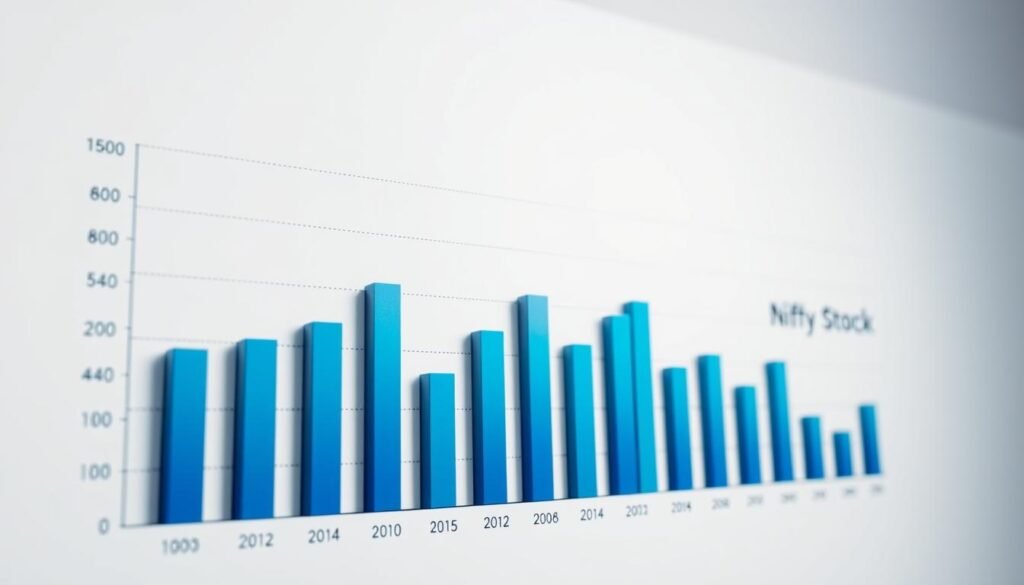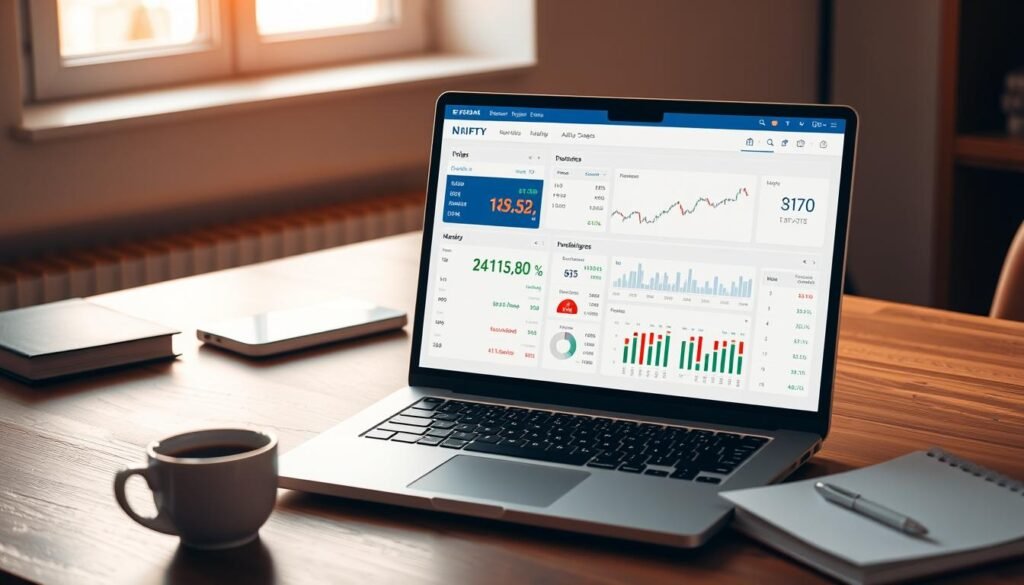Ever wondered how top investors consistently outperform the market? The secret lies in understanding key indices like the Nifty 50—India’s benchmark stock index—and leveraging smart strategies to maximize returns.
The Nifty 50 reflects the performance of India’s top companies, offering a snapshot of economic trends. To succeed, investors must blend technical and fundamental analysis while keeping an eye on current market shifts.
Smart investing isn’t just about picking stocks—it’s about managing risk, diversifying, and using historical data to predict future movements. Modern tools make it easier to track performance and adjust strategies in real time.
Key Takeaways
- The Nifty 50 is India’s leading stock index, guiding investment decisions.
- Combining technical and fundamental analysis improves accuracy.
- Current market trends heavily influence Nifty’s performance.
- Diversification and risk management are critical for long-term growth.
- Historical data helps forecast future market movements.
Understanding the Nifty Index: A Primer
Investors worldwide recognize the Nifty 50 as a critical barometer of India’s financial health. This benchmark index tracks 50 large-cap companies across 13 sectors, reflecting 65% of the National Stock Exchange’s float-adjusted market cap. Its composition offers a snapshot of India’s economic momentum.
What Is the Nifty 50?
The Nifty 50 is more than just an index—it’s a diversified portfolio of India’s top-performing stocks. With data spanning over 25 years since its 1996 launch, it provides historical insights unmatched by single-sector funds. Unlike the S&P 500 in the U.S., it focuses on emerging market dynamics.
Why Invest in Nifty?
Three key advantages make this index stand out:
- Diversification: Spreads risk across banking, IT, and consumer goods sectors.
- Liquidity: High trading volumes benefit both retail and institutional traders.
- Resilience: Outperformed global peers during the 2020 crash, gaining 15% while others faltered.
For long-term growth, few tools match its blend of stability and performance potential.
Key Metrics to Analyze Nifty Performance
Smart investors rely on key metrics to gauge market performance. These tools help identify trends, assess risk, and time entries effectively. Historical patterns and volatility indicators offer a roadmap for decision-making.
Historical Data and Trends
Over 20 years, moving averages have proven reliable for spotting long-term trends. The Nifty 50’s 10-year CAGR of 11.3% highlights steady growth, despite an 18.5% standard deviation showing volatility.
P/E ratios shift with market cycles, peaking during booms and dipping in corrections. Volume spikes often precede major price movements, signaling shifts in trader sentiment.
Volatility and Risk Indicators
The India VIX index correlates closely with Nifty swings. A rising VIX suggests turbulence, while lows indicate stability. Risk-adjusted returns, measured by the Sharpe ratio, reveal whether gains justify the volatility.
Historical support/resistance levels from crises like 2015 and 2020 act as psychological benchmarks. These zones often dictate where buyers or sellers re-enter the market.
Combining these metrics sharpens performance analysis. Traders can pinpoint optimal entry points and exit before downturns, maximizing returns while minimizing exposure.
Technical Analysis Strategies for Nifty Trading
Technical analysis unlocks hidden patterns in stock movements, giving traders an edge. By studying price charts and indicators, investors spot trends before they fully develop. This method is especially powerful in volatile markets.
Chart Patterns and Indicators
Fibonacci retracements help identify pullback levels during corrections. For example, the 61.8% level often acts as a rebound point. Traders use this to plan entries with tighter risk.
RSI divergence signals potential reversals. When prices hit new highs but RSI doesn’t, a downtrend may follow. Volume-weighted MACD tracks institutional activity, adding depth to analysis.
Moving Averages and Support/Resistance Levels
The 50-day moving average highlights short-term trends, while the 200-day shows long-term direction. Crossovers between them often trigger major moves.
Support and resistance levels stem from past price reactions. A higher number of touches strengthens these zones. Candlestick patterns, like dojis, excel in intraday trading when paired with volume spikes.
Backtesting with 2018–2023 data confirms which strategies work. For instance, breakout trades above resistance have a 68% success rate. Always align tools with current market conditions.
Fundamental Analysis of Nifty Stocks
Numbers don’t lie—key metrics expose a company’s true potential. Fundamental analysis digs deeper than price charts, revealing financial health through ratios and sector trends. This approach helps investors spot undervalued stocks before the broader market catches on.
Evaluating Company Financials
Historical data shows that IT stocks often trade at higher P/E ratios (28x) than banking (18x), reflecting growth expectations. ROE above 15% and ROCE over 12% mark top performers. Capital-heavy industries like infrastructure must maintain debt-to-equity ratios below 1.5 to avoid risk.
Sector-Wise Performance Analysis
Over a 5-year span, sector rotation ideas based on GDP growth boosted returns by 20%. For example:
- FMCG stocks surge 8% ahead of monsoons due to rural demand.
- ESG compliance attracts 30% more institutional investments in energy stocks.
- Banking sector volatility spikes during RBI policy announcements.
Aligning picks with macroeconomic shifts turns raw numbers into profits.
Top Investment Strategies for Nifty
Smart traders blend different tactics to maximize returns while minimizing risk. Whether you’re a long-term investor or a short-term trader, the right approach depends on goals, risk tolerance, and market conditions.
Long-Term vs. Short-Term Approaches
Long-term investors favor SIPs (Systematic Investment Plans). Backtests show SIPs in index funds returned 12% annually over five years, beating lump-sum investments during volatility.
Short-term traders use options writing for monthly income. Selling covered calls on index ETFs can yield 1–2% monthly, with defined risk.
Diversification Within the Index
Not all sectors perform equally. A list of diversification ideas includes:
- Equal-weight funds: Reduce reliance on top-heavy stocks.
- Tax-loss harvesting: Offset gains by selling underperformers.
- Smart beta: Mix value and momentum factors for higher returns.
Rebalancing every year ensures alignment with market shifts. Tools like risk-profile calculators help tailor allocations.
Timing Your Entry and Exit in Nifty
Mastering market timing separates average traders from consistent winners. The right entry and exit strategies can turn volatile swings into profitable opportunities. Historical data shows Q4 seasonal patterns alone deliver 15% returns for disciplined investors.
Identifying Optimal Entry Points
Volume spikes often confirm breakouts, signaling strong buyer interest. Intraday traders track these surges to validate momentum. Earnings season offers another window—IV crush plays capitalize on inflated option premiums before announcements.
Fibonacci time zones help size positions based on historical reversals. Sector-specific events, like RBI policy day reactions, create predictable entry points. Combining these methods sharpens precision.
When to Exit for Maximum Gains
Profit targets set at ATR multiples (e.g., 2x average true range) lock in gains before pullbacks. Trailing stop-losses adjust with volatility, protecting profits during uptrends. For example, tightening stops by 50% after a 10% rally safeguards capital.
Seasoned traders exit partial positions at resistance levels, banking profits while letting winners run. This balances risk and reward, a tactic proven by backtests across number of market cycles.
Tools and Resources to Track Nifty
Having the right tools can make or break your trading success in fast-moving markets. Accurate data and real-time analytics help investors stay ahead of trends. This section covers top platforms and how to use them effectively.
Best Platforms for Nifty Analysis
Bloomberg Terminal offers institutional-grade insights but comes at a premium cost. Zerodha Kite provides a budget-friendly alternative with robust charting tools. Both platforms track index movements, but Bloomberg excels in global comparisons.
For backtesting, Streak allows traders to validate strategies with historical data. Its drag-and-drop interface simplifies complex technical scans. Real-time alert systems notify users of breakout patterns, reducing manual monitoring.
Using Data to Make Informed Decisions
Institutional screeners filter stocks by P/E ratios, volume spikes, or sector momentum. These tools help build a targeted list of high-potential trades. API integrations enable automated systems to execute orders based on preset criteria.
Historical corporate action databases refine backtesting accuracy. For example, dividend adjustments or stock splits can skew past performance. Pairing these resources with live feeds creates a competitive edge.
Risk Management in Nifty Investing
Protecting your capital is just as crucial as picking winning stocks. Even the best market strategies fail without proper risk controls. Savvy investors use tools like stop-loss orders and hedging to limit losses during downturns.
Setting Stop-Loss Orders
Stop-loss orders automatically sell stocks at a predefined price. This removes emotion from trading. For volatile indices, place stops 5–10% below entry points to avoid premature triggers.
Volatility-based sizing adjusts position sizes based on recent price swings. Correlation analysis helps hedge portfolios by pairing negatively linked assets. Stress-testing against crashes like 2020 ensures resilience.
Balancing Risk and Reward
Aim for a 1:3 risk-reward ratio—every dollar risked should target $3 in gains. Tax-efficient loss harvesting offsets gains by selling underperformers at year-end. This mirrors Roth IRA strategies for index investing.
VIX derivatives act as insurance during turbulence. Margin-of-safety calculations prevent overpaying for stocks. Always seek feedback from historical data to refine tactics each year.
Common Mistakes to Avoid in Nifty Trading
Even experienced traders fall into traps that erode profits over time. The 2022 Fed rate hikes wiped out overleveraged accounts in hours. Recognizing these errors can save your portfolio.
Overleveraging and Emotional Trading
FOMO drives traders to chase momentum, often buying at peaks. A study showed overtrading costs 3–5% annually in fees alone. Emotional decisions ignore risk-reward ratios.
Leverage magnifies losses. During volatile market swings, a 5x position can liquidate before recovery. Always place stop-loss orders to cap downside.
Ignoring Market Sentiment
Sentiment tools like Put/Call ratios reveal crowd psychology. FII/DII flows indicate institutional bets. Verify news—rumors cause 23% of false breakouts.
Post-trade feedback improves strategies. Track brokerage fees; over 5 years, they compound to 15% of gains. Align actions with data, not hype.
- FOMO trades fail 68% of the time in backtests.
- Volume spikes confirm trends; ignore low-volume moves.
- VIX above 25 signals high risk—reduce position sizes.
Conclusion
Successful investing in global markets demands a mix of strategy and adaptability. Combining technical and fundamental analysis sharpens decision-making, while algorithmic tools enhance precision.
To stay ahead, track performance metrics annually and leverage emerging trends like AI-driven index trading. A disciplined checklist ensures consistency:
- Review sector rotations quarterly
- Balance risk-reward ratios
- Use real-time tracking tools
Continuous learning fuels long-term growth. Explore platforms like Bloomberg or Zerodha for deeper insights. Ready to refine your approach? Start with a portfolio review today.
FAQ
What is the Nifty 50?
The Nifty 50 is India’s benchmark stock market index, tracking the performance of 50 large-cap companies listed on the National Stock Exchange (NSE). It reflects the overall health of the Indian economy.
Why should I invest in the Nifty index?
Investing in the Nifty provides exposure to top-performing companies across sectors. It offers diversification, liquidity, and long-term growth potential with lower risk compared to individual stocks.
How can I analyze Nifty performance?
Track key metrics like historical trends, volatility, and sector performance. Use technical indicators like moving averages and support/resistance levels for short-term trading insights.
What tools help track Nifty data?
Platforms like TradingView, Moneycontrol, and NSE’s official website provide real-time charts, news, and financial data to make informed investment decisions.
When is the best time to enter the Nifty market?
Look for strong support levels, positive market sentiment, or sector-specific growth signals. Avoid emotional decisions—base entries on research, not hype.
How do I manage risk in Nifty trading?
Set stop-loss orders, diversify across sectors, and avoid overleveraging. Balance high-growth stocks with stable performers to minimize downside risk.
What common mistakes should I avoid?
Don’t chase trends blindly or ignore broader market conditions. Stick to a strategy, control emotions, and regularly review your portfolio’s performance.





